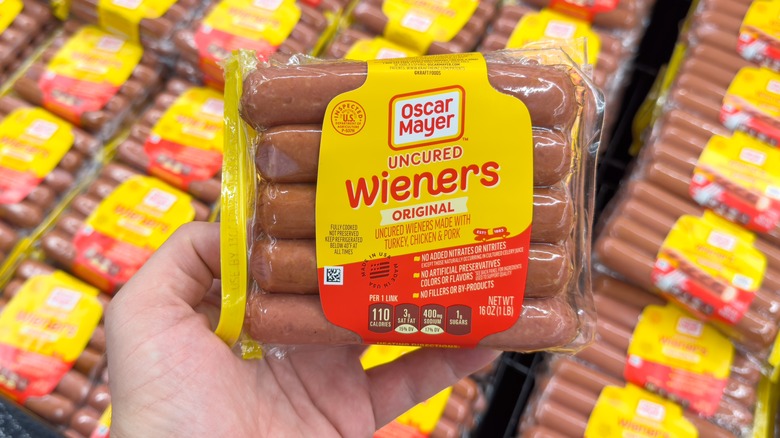Is It Safe To Eat Raw Hot Dogs?
During the pinnacle of hot dog season between Memorial Day and Labor Day, it's estimated that Americans consume roughly 7 billion coneys. Many enjoy frankfurters fresh off the grill during a cookout, and others like to boil them and cleverly transport the cooked hot dogs to a picnic during these warm summer months. One thing you don't see, however, is people taking them straight out of the package and eating them raw, and there's a good reason for this.
Hot dogs do contain preservatives that discourage the growth of bacteria, but their presence in the ingredient list isn't a guarantee the franks are free of such dangerous food-borne pathogens. Refrigerating also slows bacterial growth, but again, not a guarantee. Some foods that look and smell fine can still harbor pathogens that can make someone sick. Hot dogs should always be cooked to an internal temperature of 160 degrees Fahrenheit to ensure they are safe to eat. We can lump chowing down on raw hot dogs in with the other bad advice of cooking them inside their plastic packaging.
How bad could a raw hot dog be?
You may think that the likelihood of becoming ill from eating a raw hot dog is minimal, but it's not a gamble worth posting. All raw meat has the potential to transfer harmful bacteria, but what a hot dog is made of and how it's produced makes this processed meat even more problematic regarding possible food-borne illness. Two harmful pathogens uncooked franks can contain are salmonella and E. coli. These can both cause symptoms of nausea, vomiting, diarrhea, and more severe complications that warrant seeking professional medical attention. In some cases – especially when it concerns young children and elderly folks – the food-borne bacteria potentially living inside a raw hot dog can lead to hospitalization and worse.
Even precooked and ready-to-eat hot dogs should not be consumed without cooking them. These products can shelter Listeria monocytogenes, a bacterium that has the unusual ability to survive under the colder temperatures of refrigeration. Listeriosis can cause fevers, muscle aches, and diarrhea, and it can be even more dangerous for those who are pregnant.
What about uncured hot dogs?
Uncured hot dogs – sometimes labeled "no nitrates or nitrites added" on their packaging — are labeled that way as a reference to what kind of nitrates or nitrites are in the product. Although, according to Harvard Health, the jury is still out on how problematic these may be to our health, many folks are concerned with the association of nitrates and certain cancers and try to avoid them whenever possible. These chemicals keep the hot dogs fresh and can inhibit the growth of bacteria like botulism – a food-borne illness that can cause symptoms of nausea, breathing complications, and, in some extreme cases, paralysis. While these products do contain natural nitrates/nitrites in the form of celery powder and other natural preservatives, they aren't meant to be eaten without cooking them beforehand.
If you are famished and that package of raw hot dogs in the fridge is calling your name, consider taking just a few minutes to cook the franks thoroughly. An air fryer can cook a weenie in five minutes, and if you're willing to forgo a more enjoyable meaty texture, the microwave can cook a hot dog in less than a minute. The grill is arguably the best choice for the ultimate flavor and mouthfeel, but it does take slightly longer to make a two-zone fire on the grill to properly cook the dogs. Whatever you do, save yourself from a potentially dreadful experience and cook your hot dogs any way you can.


